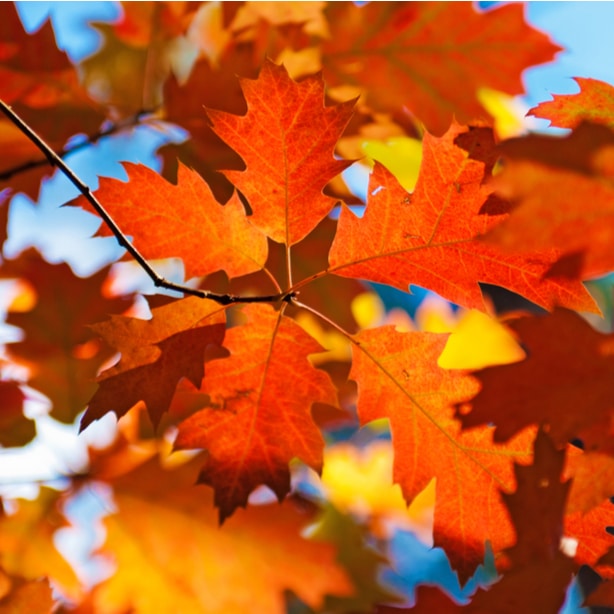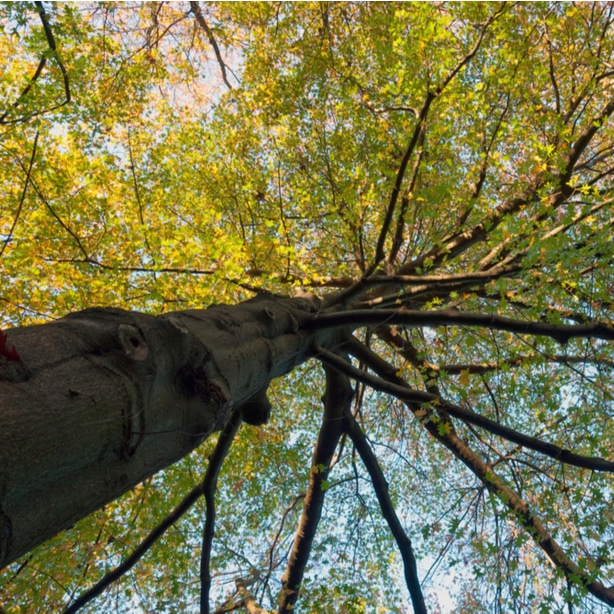If you’ve ever driven down a quaint, quiet road and noticed that it is lined on both sides with this “street” tree that has majestic branches that form a picturesque crown, then you’ve no doubt encountered this variety.
These trees are found from Nova Scotia to Minnesota. Besides that East to West boundary, you’ll find that they extend all the way south to Louisiana.
Its familiar leaves also play a role in commemorating people in the military service. The leaf clusters, along with their acorns, adorn service ribbons to denote that someone has received that award multiple times.
If that’s not enough, I assure you that if you’ve ever walked on an old wood floor, you are familiar with this tree. Its sturdy wood has been used for flooring and furniture for centuries.
As you can see, the red oak tree is present in our lives in so many ways. They are a stately and elegant addition to your property that can be around for generations. And if you’re thinking of lining your street with oaks or just want something for the kids and squirrels to climb on, you must read this article so you know the essential information to planting and growing them the right way.

General Information
The northern red oak, Quercus rubra, is a tree native to North America that is one of several oak species growing throughout the continent. It is generally referred to as red oak, but it carries the northern specification to distinguish it from the southern red oak or Spanish oak.
In forests, this deciduous tree grows to be between 90 and 150 feet tall with a trunk that measures between 1 ½ and 3 ½ feet in diameter. However, when grown in open areas, the tree will not grow nearly as tall (60 to 75 feet) but will produce a much broader trunk that can reach 7 feet in diameter.
It is fast-growing (2 feet per year) and has strong, thick branches that grow outward from the base at square angles. The smaller branches growing towards the higher points of the base raise upward to form a narrow, rounded crown with a breadth of around 45 feet in forest settings. The crown of specimens grown in the open can be as broad as 75 feet.
The northern red oak has an easily recognizable and very distinctive bark. While its color can vary from a dark reddish-brown to gray depending on the age of the tree, its rounded ridges with shiny stripes running down the center remain consistent. The ridges are scale-like and occur in great numbers throughout the entire base of the tree.
Its alternately growing leaves appear in spring when the length of the day extends to 13 hours. The leaves’ appearance is entirely dependent on this photoperiod and will leaf-out regardless of the temperature. The leaves grow to lengths between 5 and 10 inches with breadths of 4 to 6 inches and taper gradually towards the tip from broader bases. The simple leaves have 7 to 11 lobes, each with a bristle at the tip. The leaves are a dark green hue on the upper surface and slightly paler on the lower in the summer months. They turn from a deep, lustrous red or yellow into a brighter red or yellow as it gets deeper into fall.

The male and female flowers appear separately on the tree. Female flowers are tiny spikes that are located in the axils of new leaves. Male flowers are hanging catkins that appear in early spring.
The familiar barrel-shaped acorns are ¾ to 1 inch long and are a moderate shade of brown. Mature acorns take 2 years to drop to the ground. The thin cap does not completely cover the top of the acorn and has a scaly appearance.
Its winter buds are reddish-brown and are generally around ¼ of an inch long.
The wood of the red oak is a pale reddish-brown with a distinct and desirable grain. Its shock resistance makes it an ideal choice for use as railroad ties. Although the wood tends to crack during drying, treated lumber is a popular choice among carpenters for nearly any indoor construction project.
Care Guide
Here are the things that you’ll need to provide your red oak with to ensure it grows happy and healthy for the next 400 years.
Sunlight Requirements
The red oak grows best in full sun conditions. Although it prefers 4 to 6 hours of direct sunlight, it can also grow in partial sun and partial shade. It does not do well in hot temperatures, so the location where it is planted should have a temperate climate.
Water Requirements
Newly planted trees will require weekly watering until the roots are established. Water deeply and ensure that the moisture soaks the soil to a depth of 2 feet. During hotter periods, red oaks benefit from additional watering to maintain the integrity of their young roots.
Established oaks are relatively tolerant of drought. They won’t need irrigation unless extended periods of drought and higher temperatures occur.

Soil Conditions
The red oak prefers acidic soil. Slightly alkaline soil, 7.5 or higher, can lead to an iron deficiency that will cause chlorosis. This results in the yellowing of the leaves. The tree does best in soils with a pH level between 5.0 and 6.0. However, they tolerate acidity well enough that they will still exhibit good growth with a pH level as low as 4.0. They also do well in neutral soil.
The trees can grow in a wide variety of soil consistencies provided that the soil is well-drained. The fertile soil should be deep enough to contain the large root system and remain moist but not soggy.
Fertilization
Like other oak species, the red oak is hardy enough that it rarely need supplemental fertilization to sustain healthy and continuous growth. This is especially true for specimens planted in a lawn that is already being fertilized.
If you find it necessary to fertilize your tree, do so in the early spring before the initial phases of the growing season begin. Use a fertilizer with an NPK ratio of either 12-4-8 or 12-6-6. The higher nitrogen level is because, generally, that is the nutrient most commonly deficient in trees. Apply approximately 2 pounds of fertilizer per 1000 square feet.
Also, if you do fertilize your tree, don’t do it in the first year of growth as it can be harmful to the developing tree.
An environmentally friendly alternative to fertilization is to place 2 to 3 inches of organic mulch around the base of the tree. Not only will the organic material decompose and provide nutrients naturally to the soil, but it will also help the soil retain its moisture. You’ll need to check on the mulch regularly and replenish it when necessary.

Pruning
Only prune your tree in the winter months. This will ensure that your tree does not contract oak wilt. Oak wilt occurs when bugs feed on the sap of limbs that have just been pruned. The bug carries spores from an infected tree to the sap of the tree you just trimmed. Oak wilt, in some cases, can cause death.
For trees under three years old, only trim back dead or damaged limbs. This will prevent damage to young, healthy limbs that are still developing.
For trees that are older than 3, only remove branches that are growing towards the center of the tree if you’re pruning to shape. Be mindful of branches that are rubbing against one another or that are too close for comfort. This contact can open up wounds and make the tree vulnerable to disease.
Always trim back any dead, diseased, or damaged branches until you reach living tree tissue. Take the time to bandage the tree at the point you pruned it for an added layer of protection.
Growing Tips
Keep the information that follows here in mind to ensure that your red oak grows healthy and strong so that it’s around for the generations that follow to enjoy.
Try To Recreate the Tree’s Preferred Environment
The northern red oak is found in various climates and growing conditions, but they grow best in coves and ravines because the soil stays moist. These low-lying areas have sloping floors and deep, well-drained soil with loamy and sandy consistencies. Although it might not be practical for your property, it’s worth mentioning that these trees prefer north, northeast, or east-facing exposure.
If possible, recreate this environment by amending clay soil with sand, so it’s not as dense, or by using mulch to help the soil stay moist. Those are a couple of ideas out of many that will benefit your tree. Any way you can reproduce these preferred growing conditions, even in a small way, can be helpful.
Choose the Right Location
Oaks grow to be very large above and below the surface. It’s important to give it enough room to grow to its full potential unhindered. Take notice of your home, power lines, other outdoor structures, and account for underground utility lines as well.
Branches can fall onto these structures and cause significant damage and possible injury. Roots can damage anything they grow into below the surface as well. So choose the spot carefully.
If you’re planting multiple trees, ensure that they have at least 25 feet between them to allow for unencumbered growth.

Prepare the Soil Before Planting
The red oak and the other members of the Quercus genus have developed a symbiotic relationship with beneficial mycorrhizal fungi. These microbes live among the roots and provide them with moisture and assorted minerals. In return, the roots provide a food source for the mycorrhizal fungi in the sugars that they naturally excrete into the soil.
This relationship is essential to the life and longevity of the oak. You can ensure that the symbiosis continues by amending the soil at the planting site with compost or manure. The microbial activity in these two mediums is very high and will set your oak up for continued success.
This is recommended no matter where you decide to plant your oak, but it is especially important in a city or other urban environment. The soil in urban areas has a higher likelihood of being deficient in these essential fungi.

Planting
Oaks are best grown from saplings with root balls as opposed to acorns. But, if you have the time and the patience, acorns are just as viable and the way nature intended.
For saplings, dig a hole twice as wide as the root ball and just deep enough to contain it. You’ve already amended the soil with the compost or manure to support microbial activity, so place the root ball into the hole and ensure that the sapling is standing up straight. Backfill the hole carefully and ensure that it remains perpendicular to the ground. An error here will cause your oak to grow in at an unsightly angle.
Once you’ve backfilled the hole, water the area immediately to saturate the soil containing the root ball. Water weekly to ensure that the soil stays moist and the roots establish themselves.
For acorns, it’s best to start them in a pot so that wildlife doesn’t destroy them. Be careful not to let the roots become too established in the pot. This will make transplanting it to the ground difficult for you and dangerous for the oak.

